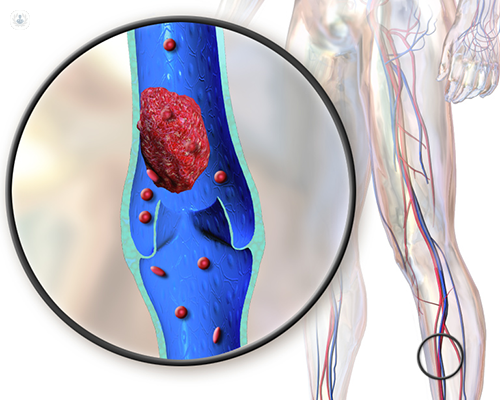How is deep vein thrombosis treated?
Escrito por:In one of our latest articles here, Mr David Greenstein, a revered consultant vascular surgeon, describes in detail what deep vein thrombosis is, how it is typically diagnosed, and whether or not it can potentially be life-threatening.

Can you describe what deep vein thrombosis is?
Essentially, it is a blood clot in the deep veins of the leg, pelvis, or the abdomen. It is a very serious condition, but in the majority of cases, it does not cause profound complications. In some patients, patients can suffer very swollen legs. It can occur in the arms as well sometimes.
How is it diagnosed? What are the main symptoms typically reported?
The main symptom of deep vein thrombosis of the leg is noticeable leg pain that has occurred from long-haul travel, but can also just occur in people who have been going about their daily activities. It can also be provoked by a previous injury.
The most typically reported symptoms are pain and swelling. Very rarely, the lungs can be affected, and people would complain of sharp chest pain, shortness of breath, or coughing.
Can it be potentially life-threatening? How important is an early diagnosis?
It is potentially life-threatening, so it is very important to get an early diagnosis. If you have a deep vein thrombosis that is very small initially, they are very rarely life-threatening and very rarely cause long-term complications.
However, if you leave a deep vein thrombosis untreated, the blood clot can get bigger and bigger, and when it gets very big, it can be dangerous. It is life-threatening, because the deep vein thrombosis in the leg can break off into the bloodstream and affect the heart and lungs, leading to cardiac arrest. Fortunately, this is not common.
What underlying conditions might deep vein thrombosis indicate?
Patients can be born with sticky blood, and this is the most common underlying condition.
How is deep vein thrombosis treated? Is there a surgery that can effectively treat it?
Patients, when diagnosed with deep vein thrombosis, will need to go on blood-thinning medication immediately. The medication prevents new blood clots forming, but don’t actually dissolve and get rid of the existing blood clot.
In patients who have very swollen legs, particularly when the clot is in the thigh and pelvis, these blood clots can be removed through special medication, stents, or a keyhole procedure called a thrombectomy.
Mr David Greenstein is a highly esteemed consultant vein surgeon who specialises in deep vein thrombosis. Consult with him today via his Top Doctors profile.


